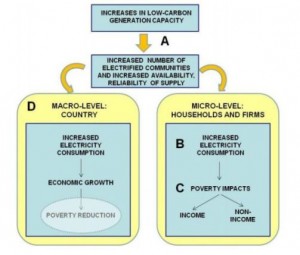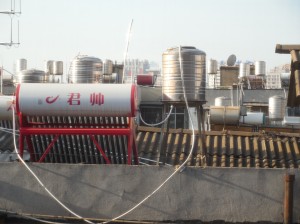According to the latest IPCC Synthesis Report there is a clear human influence on the climate system. The “unequivocal warming” can be seen very well over the last three decades, which have been warmed successively. The effects of this human induced climate destabilization can be seen in the present and are projected to worsen over time, regardless of the level of carbon emitted into the future. This does not mean that global and regional systems should not be overhauled to reduce carbon emissions. A rapid decrease in emissions is necessary to avert further warming of the planet and changes in the climate system. As the various effects of the shifting climate are being seen now, it can be clear that a level of dangerous climate change has been reached, although not threatening on a global scale. In order to ensure the perpetuity of our species in conditions that are not life threatening, a new development pattern must be adopted. The old way, some may say the “dirty way,” is no longer feasible. No longer may we dig up energy reserves that were sequestered over millions of years and burn them in a matter of hours. This is not as sustainable as once was thought. The planet is telling us that we must radically shift the way we build, develop, live, connect, move, eat, recreate, etc.
Sustainable development is a young notion, but a powerful one. Around it, is a conversation that attempts to unite every person on the planet in the hopes that we all might work together to further our species. Climate change fits into this conversation very well. Results of unsustainable development, the effects of climate change are a huge risk to the safety of our species. It however lends itself nicely to sustainable development. While posing significant threats to the stability of society, it is a driving force of this newfound development scheme. With changes in line with sustainable development, great gains in living conditions can be seen.

In looking at the driver of climate change, fossil fuels, an obvious need for doing away with all fossil fuels can be seen.
Just as important to look at though, are the public health benefits that come from reducing the burning of fossil fuels. Smog and airborne particulate matter are a huge health risk all over the world, from the smog filled skies of Beijing to the United States, where in 2013 118 of the 231 counties in the United States exceeded the EPA’s allowed level of ozone.[1] These dangers are a direct result of burning fossil fuels. Switching to power-generation systems that do not emit will not only slow global warming, it will directly save lives and promote healthier activities.
The alleviation of poverty is one of the United Nation’s direct responsibilities.[2] Taking a look at poverty one will find that about 1.3 billion people in the world do not have access to electricity.[3] One solution to this would be to build large centralized coal plants, which would be the centers of massive electricity transportation networks. This inefficient and unsustainable system is currently in place in much of the developed world. However other solutions exist. There has been a great deal of work done on the link between renewable energy and poverty alleviation. Not only studying the prospects, but actual tangible change. For instance in India, Project Chirag is bringing light to rural villages across the nation and it is being done with the use of solar panels and batteries.

Climate change has been described as the biggest challenge our species has ever faced. And a challenge it is, altering the way nature of the planet that humans have grown up in. Why look at climate change merely as a challenge? The notion that by 2100 fossil fuels must be phased out and renewable grids in place is just incredible. A recent study estimates, with an 80% chance, that the projected population by 2100 will range between 9.6 and 12.3 billion. They will all need electricity, food, water, and space. Developing for sustainability is the only option if we want to be sure that this population will be able to live safely and without struggle. Using climate change as a tool, rather than looking at it simply as challenge, to make the world a better place seems like a reasonable way to ensure that type of development.
Works Cited
“Bodies, History, Visits, Employment, Address, Members, Budget, Information.” UN News Center. Web. 2 Nov. 2014.
“Can Renewable Electricity Reduce Poverty? – Institute of Development Studies.” 13 Jan. 2014. Web. 2
Nov. 2014.
“Climate Change 2014: Synthesis Report, Longer Report.” Intergovernmental Panel on Cliamte Change.
November 1, 2014.
Gerland, Patrick, Adrian E. Raftery, Hana Sevcikova, Nan Li, Danan Gu, Thomas Spoorenberg, and John
Wilmoth, et al. 2014. “World population stabilization unlikely this century.” Science no. 6206: 234.
Resutek, Audrey. “Study: Cutting Emissions Pays for Itself.” MIT News. 24 Aug. 2014. Web. 2 Nov.
[1]http://newsoffice.mit.edu/2014/cutting-carbon-health-care-savings-0824
[2]http://www.un.org/en/aboutun/index.shtml
[3]http://www.ids.ac.uk/news/can-renewable-electricity-reduce-poverty



